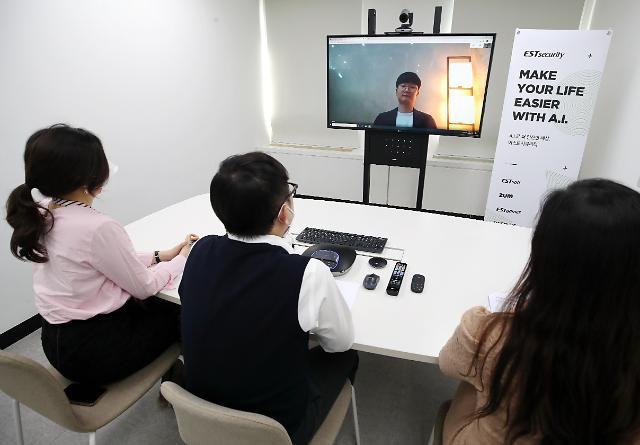 |
Employees at a company in Seocho-dong, Seoul, carry out online job interviews in a pilot test amid the pandemic earlier this year. (Yonhap) |
SEJONG -- South Korea lagged behind Japan, Russia and some Western countries this year in terms of employment among working-age people.
According to the Organization for Economic Cooperation and Development, Korea posted a 65.4 percent employment rate for those aged 15-64 during the April-June period of 2020.
In contrast, Japan -- also an OECD member -- saw the employment rate for its working-age population reach 77 percent over the corresponding period, though the country was also hit hard by the novel coronavirus.
Nonmember Russia also outstripped Korea, with an employment rate of 70.2 percent as of June.
Among those countries that have publicized their second-quarter figures and outperformed Korea are New Zealand (76.8 percent), Australia (70.5 percent) and Israel (66.7 percent). Many other OECD members have yet to disclose their corresponding figures.
 |
(Graphic by Kim Sun-young/The Korea Herald) |
In its first-quarter data, Korea lagged behind the average for the 37 OECD members, with 66.8 percent versus an average of 68.6 percent.
Switzerland posted 80.6 percent in the January-March period, followed by the Netherlands with 78.6 percent. Alongside Iceland -- whose latest figure was 83.7 percent for the fourth quarter of 2019 -- they are expected to be at the top of the list among the 37 members.
The countries with the next-highest figures were Sweden with 76.4 percent, Germany with 76.1 percent, Norway with 75.6 percent, Estonia with 75.6 percent, the UK with 75.6 percent, Denmark with 75.3 percent and the Czech Republic with 75.1 percent.
Others with figures over the OECD average as of March included Austria, Finland, Lithuania, Latvia, Slovenia, Portugal, Hungary, Ireland and Poland.
The situation in Korea was even more critical for younger people. Employment for those aged 15-24 stayed at 24.9 percent during the April-June period.
This is in contrast to 55.4 percent in New Zealand, 52.5 percent in Australia, 45.6 percent in Japan and 40.6 percent in Canada.
Countries that outperformed Korea in terms of youth employment included Israel with 38.7 percent, the US with 38.6 percent, Colombia with 27.8 percent and Russia with 25.4 percent.
But the comparison may be insignificant since Korea includes all those aged 15-29 when calculating its youth employment rates, whereas the OECD includes people aged 15-24.
Even so, Korea’s jobless figures for younger people are grim, as seen in the Supplementary Index III for Employment, held by Statistics Korea.
The index shows that the de facto youth unemployment rate, which is published each month, ranged between 20 percent and 26 percent over the past three years.
The index regards underemployed people -- who work fewer than 36 hours a week and want to work more hours, as well as seasonal workers who are out of work for part of the year -- as unemployed.
Past data from the OECD indicates that Korea has been underperforming in the hiring sector compared with most other members, irrespective of the latest figures, which are affected by the pandemic, said an analyst in Seoul.
In July, the number of unemployed plus underemployed for those aged 15-29 came to 1.25 million out of the economically active population of 4.91 million, with the de facto jobless rate reaching 25.6 percent.
By Kim Yon-se (
kys@heraldcorp.com)







![[Exclusive] Hyundai Mobis eyes closer ties with BYD](http://res.heraldm.com/phpwas/restmb_idxmake.php?idx=644&simg=/content/image/2024/11/25/20241125050044_0.jpg)
![[Herald Review] 'Gangnam B-Side' combines social realism with masterful suspense, performance](http://res.heraldm.com/phpwas/restmb_idxmake.php?idx=644&simg=/content/image/2024/11/25/20241125050072_0.jpg)
